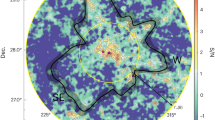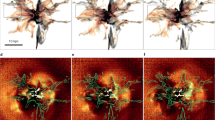Abstract
It is a firm prediction of the concordance cold-dark-matter cosmological model that galaxy clusters occur at the intersection of large-scale structure filaments1. The thread-like structure of this ‘cosmic web’ has been traced by galaxy redshift surveys for decades2,3. More recently, the warm–hot intergalactic medium (a sparse plasma with temperatures of 105 kelvin to 107 kelvin) residing in low-redshift filaments has been observed in emission4 and absorption5,6. However, a reliable direct detection of the underlying dark-matter skeleton, which should contain more than half of all matter7, has remained elusive, because earlier candidates for such detections8,9,10 were either falsified11,12 or suffered from low signal-to-noise ratios8,10 and unphysical misalignments of dark and luminous matter9,10. Here we report the detection of a dark-matter filament connecting the two main components of the Abell 222/223 supercluster system from its weak gravitational lensing signal, both in a non-parametric mass reconstruction and in parametric model fits. This filament is coincident with an overdensity of galaxies10,13 and diffuse, soft-X-ray emission4, and contributes a mass comparable to that of an additional galaxy cluster to the total mass of the supercluster. By combining this result with X-ray observations4, we can place an upper limit of 0.09 on the hot gas fraction (the mass of X-ray-emitting gas divided by the total mass) in the filament.
This is a preview of subscription content, access via your institution
Access options
Subscribe to this journal
Receive 51 print issues and online access
$199.00 per year
only $3.90 per issue
Buy this article
- Purchase on Springer Link
- Instant access to full article PDF
Prices may be subject to local taxes which are calculated during checkout



Similar content being viewed by others
References
Bond, J. R., Kofman, L. & Pogosyan, D. How filaments are woven into the cosmic web. Nature 380, 603–606 (1996)
Joeveer, M., Einasto, J. & Tago, E. Spatial distribution of galaxies and of clusters of galaxies in the southern galactic hemisphere. Mon. Not. R. Astron. Soc. 185, 357–370 (1978)
Geller, M. J. & Huchra, J. P. Mapping the universe. Science 246, 897–903 (1989)
Werner, N. et al. Detection of hot gas in the filament connecting the clusters of galaxies Abell 222 and Abell 223. Astron. Astrophys. 482, L29–L33 (2008)
Buote, D. A. et al. X-ray absorption by WHIM in the Sculptor Wall. Astrophys. J. 695, 1351–1356 (2009)
Fang, T. et al. Confirmation of X-ray absorption by warm-hot intergalactic medium in the Sculptor Wall. Astrophys. J. 714, 1715–1724 (2010)
Aragón-Calvo, M. A., van de Weygaert, R. & Jones, B. J. T. Multiscale phenomenology of the cosmic web. Mon. Not. R. Astron. Soc. 408, 2163–2187 (2010)
Kaiser, N. et al. A photometric and weak lensing analysis of the z = 0.42 supercluster MS0302+17. Preprint at http://arxiv.org/abs/astro-ph/9809268 (1998)
Gray, M. E. et al. Probing the distribution of dark matter in the A901/902 supercluster with weak lensing. Astrophys. J. 568, 141–162 (2002)
Dietrich, J. P., Schneider, P., Clowe, D., Romano-Díaz, E. & Kerp, J. Weak lensing study of dark matter filaments and application to the binary cluster A 222 and A 223. Astron. Astrophys. 440, 453–471 (2005)
Gavazzi, R., Mellier, Y., Fort, B., Cuillandre, J.-C. & Dantel-Fort, M. Mass and light in the supercluster of galaxies MS0302+17. Astron. Astrophys. 422, 407–422 (2004)
Heymans, C. et al. The dark matter environment of the Abell 901/902 supercluster: a weak lensing analysis of the HST STAGES survey. Mon. Not. R. Astron. Soc. 385, 1431–1442 (2008)
Dietrich, J. P., Clowe, D. I. & Soucail, G. Spectroscopy of the neighboring massive clusters Abell 222 and Abell 223. Astron. Astrophys. 394, 395–403 (2002)
Navarro, J. F., Frenk, C. S. & White, S. D. M. A universal density profile from hierarchical clustering. Astrophys. J. 490, 493–508 (1997)
Dolag, K. et al. Numerical study of halo concentrations in dark-energy cosmologies. Astron. Astrophys. 416, 853–864 (2004)
King, I. R. The structure of star clusters. III. Some simple dynamical models. Astron. J. 71, 64–75 (1966)
Colberg, J. M., Krughoff, K. S. & Connolly, A. J. Intercluster filaments in a ΛCDM Universe. Mon. Not. R. Astron. Soc. 359, 272–282 (2005)
Mead, J. M. G., King, L. J. & McCarthy, I. G. Probing the cosmic web: intercluster filament detection using gravitational lensing. Mon. Not. R. Astron. Soc. 401, 2257–2267 (2010)
Kahn, F. D. & Woltjer, L. Intergalactic matter and the galaxy. Astrophys. J. 130, 705–717 (1959)
Sandage, A. The redshift-distance relation. IX—Perturbation of the very nearby velocity field by the mass of the Local Group. Astrophys. J. 307, 1–19 (1986)
Simionescu, A. et al. Baryons at the edge of the X-ray-brightest galaxy cluster. Science 331, 1576–1579 (2011)
Ilbert, O. et al. Accurate photometric redshifts for the CFHT legacy survey calibrated using the VIMOS VLT deep survey. Astron. Astrophys. 457, 841–856 (2006)
Allen, S. W. et al. Improved constraints on dark energy from Chandra X-ray observations of the largest relaxed galaxy clusters. Mon. Not. R. Astron. Soc. 383, 879–896 (2008)
Davé, R. et al. Baryons in the warm-hot intergalactic medium. Astrophys. J. 552, 473–483 (2001)
Miller, L., Kitching, T. D., Heymans, C., Heavens, A. F. & van Waerbeke, L. Bayesian galaxy shape measurement for weak lensing surveys—I. Methodology and a fast-fitting algorithm. Mon. Not. R. Astron. Soc. 382, 315–324 (2007)
Kitching, T. D., Miller, L., Heymans, C. E., van Waerbeke, L. & Heavens, A. F. Bayesian galaxy shape measurement for weak lensing surveys—II. Application to simulations. Mon. Not. R. Astron. Soc. 390, 149–167 (2008)
Acknowledgements
J.P.D. was supported by NSF grant AST 0807304. A.S. acknowledges support from the National Aeronautics and Space Administration through Einstein Postdoctoral Fellowship Award Number PF9-00070.
Author information
Authors and Affiliations
Contributions
J.P.D. led the project, reduced the optical data, performed the weak lensing analysis and wrote the manuscript. N.W. contributed to the writing of the manuscript. N.W., A.F. and A.S. performed the X-ray analysis and estimated the gas mass. L.M. and T.K. wrote the shear estimation code. The timing argument was made by D.C. All authors discussed all results and commented on the manuscript.
Corresponding author
Ethics declarations
Competing interests
The authors declare no competing financial interests.
Supplementary information
Supplementary Information
This file contains Supplementary Text and additional references, Supplementary Figure 1 which shows the E- and B-mode reconstruction of the A 222/223 supercluster field and Supplementary Figure 2 which shows the posterior probability distributions for the 8 free parameters when we leave the ellipticity of A 222 and A 223-S free. (PDF 479 kb)
Rights and permissions
About this article
Cite this article
Dietrich, J., Werner, N., Clowe, D. et al. A filament of dark matter between two clusters of galaxies. Nature 487, 202–204 (2012). https://doi.org/10.1038/nature11224
Received:
Accepted:
Published:
Issue Date:
DOI: https://doi.org/10.1038/nature11224
This article is cited by
-
Weak-lensing detection of intracluster filaments in the Coma cluster
Nature Astronomy (2024)
-
Cosmological N-body simulations: a challenge for scalable generative models
Computational Astrophysics and Cosmology (2019)
-
Assessing the influence of one astronomy camp over 50 years
Nature Astronomy (2019)
-
Fast cosmic web simulations with generative adversarial networks
Computational Astrophysics and Cosmology (2018)
-
Cosmology and fundamental physics with the Euclid satellite
Living Reviews in Relativity (2018)
Comments
By submitting a comment you agree to abide by our Terms and Community Guidelines. If you find something abusive or that does not comply with our terms or guidelines please flag it as inappropriate.



